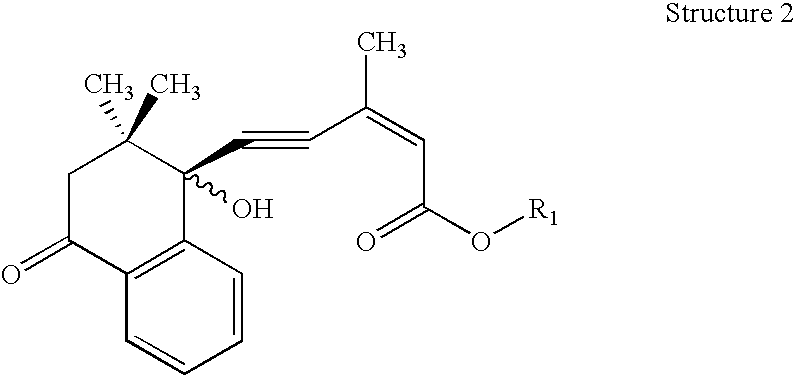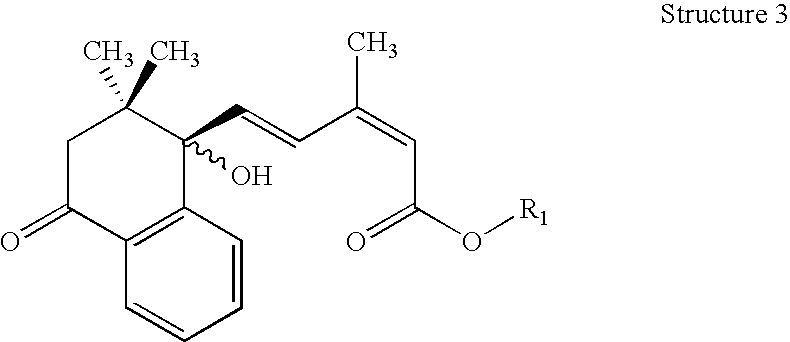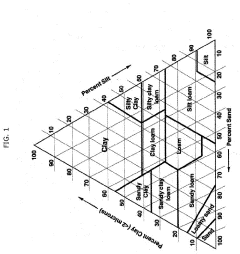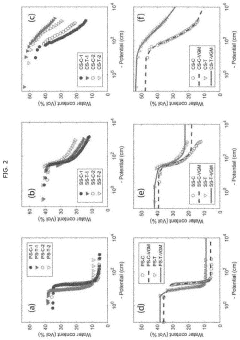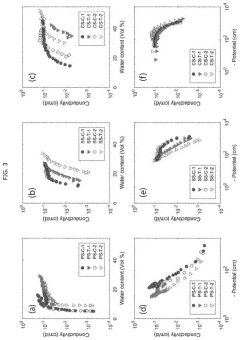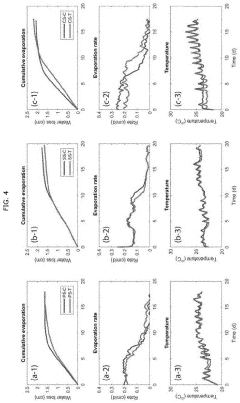How Abscisic Acid Improves Water Retention in Soil-Plant Systems?
JUL 14, 20259 MIN READ
Generate Your Research Report Instantly with AI Agent
Patsnap Eureka helps you evaluate technical feasibility & market potential.
ABA Background and Objectives
Abscisic acid (ABA) is a plant hormone that plays a crucial role in regulating various physiological processes, particularly in response to environmental stresses. Discovered in the 1960s, ABA has been the subject of extensive research due to its significant impact on plant growth, development, and stress tolerance. The primary focus of this technical research report is to explore how ABA improves water retention in soil-plant systems, a critical aspect of plant survival and agricultural productivity.
The evolution of ABA research has been marked by several key milestones. Initially identified as a compound involved in leaf abscission, scientists soon discovered its broader implications in plant physiology. Over the decades, researchers have unraveled the complex biosynthetic pathways, signaling mechanisms, and physiological responses associated with ABA. This progression has led to a deeper understanding of ABA's role in drought tolerance, stomatal regulation, and water use efficiency.
In the context of water retention in soil-plant systems, ABA's significance cannot be overstated. As global climate change continues to exacerbate water scarcity issues, developing strategies to enhance water retention has become a priority in agriculture and environmental management. ABA's ability to modulate plant responses to water stress makes it a prime target for research aimed at improving crop resilience and water use efficiency.
The primary objectives of this technical research are multifaceted. Firstly, we aim to comprehensively review the current understanding of ABA's mechanisms in improving water retention. This includes examining its effects on stomatal closure, root hydraulic conductivity, and osmotic adjustment. Secondly, we seek to explore the latest advancements in ABA-related technologies, such as synthetic ABA analogs and genetic modifications that enhance ABA sensitivity or production in plants.
Furthermore, this research aims to investigate the potential applications of ABA in agricultural practices and soil management. This involves assessing the feasibility of exogenous ABA applications, the development of ABA-responsive crop varieties, and the integration of ABA-based strategies in irrigation and soil conservation techniques. By examining these aspects, we hope to identify innovative approaches to leverage ABA's water retention properties in practical, large-scale applications.
Another crucial objective is to analyze the challenges and limitations associated with ABA-based water retention strategies. This includes addressing issues such as potential side effects on plant growth and yield, the economic viability of ABA applications, and the long-term sustainability of these approaches. By critically evaluating these factors, we can provide a balanced perspective on the potential of ABA in addressing water retention challenges in soil-plant systems.
Lastly, this research aims to outline future directions and potential breakthroughs in ABA-related water retention technologies. By identifying emerging trends and promising research areas, we can guide future investigations and development efforts in this critical field. This forward-looking approach is essential for anticipating and preparing for the evolving challenges in water management and plant stress tolerance.
The evolution of ABA research has been marked by several key milestones. Initially identified as a compound involved in leaf abscission, scientists soon discovered its broader implications in plant physiology. Over the decades, researchers have unraveled the complex biosynthetic pathways, signaling mechanisms, and physiological responses associated with ABA. This progression has led to a deeper understanding of ABA's role in drought tolerance, stomatal regulation, and water use efficiency.
In the context of water retention in soil-plant systems, ABA's significance cannot be overstated. As global climate change continues to exacerbate water scarcity issues, developing strategies to enhance water retention has become a priority in agriculture and environmental management. ABA's ability to modulate plant responses to water stress makes it a prime target for research aimed at improving crop resilience and water use efficiency.
The primary objectives of this technical research are multifaceted. Firstly, we aim to comprehensively review the current understanding of ABA's mechanisms in improving water retention. This includes examining its effects on stomatal closure, root hydraulic conductivity, and osmotic adjustment. Secondly, we seek to explore the latest advancements in ABA-related technologies, such as synthetic ABA analogs and genetic modifications that enhance ABA sensitivity or production in plants.
Furthermore, this research aims to investigate the potential applications of ABA in agricultural practices and soil management. This involves assessing the feasibility of exogenous ABA applications, the development of ABA-responsive crop varieties, and the integration of ABA-based strategies in irrigation and soil conservation techniques. By examining these aspects, we hope to identify innovative approaches to leverage ABA's water retention properties in practical, large-scale applications.
Another crucial objective is to analyze the challenges and limitations associated with ABA-based water retention strategies. This includes addressing issues such as potential side effects on plant growth and yield, the economic viability of ABA applications, and the long-term sustainability of these approaches. By critically evaluating these factors, we can provide a balanced perspective on the potential of ABA in addressing water retention challenges in soil-plant systems.
Lastly, this research aims to outline future directions and potential breakthroughs in ABA-related water retention technologies. By identifying emerging trends and promising research areas, we can guide future investigations and development efforts in this critical field. This forward-looking approach is essential for anticipating and preparing for the evolving challenges in water management and plant stress tolerance.
Market Demand Analysis
The market demand for technologies that improve water retention in soil-plant systems, particularly those involving abscisic acid (ABA), has been steadily increasing in recent years. This growth is primarily driven by global concerns over water scarcity, climate change, and the need for sustainable agricultural practices.
Agriculture remains the largest consumer of freshwater globally, accounting for approximately 70% of all freshwater withdrawals. With increasing population pressure and changing climate patterns, the demand for water-efficient farming techniques is at an all-time high. Technologies that can enhance water retention in soil and improve plant water use efficiency are therefore highly sought after in the agricultural sector.
The global market for drought-resistant seeds and water-efficient crop technologies is expected to grow significantly in the coming years. Farmers, especially in arid and semi-arid regions, are increasingly adopting drought-tolerant crop varieties and water management solutions to mitigate the impacts of water stress on crop yields.
Abscisic acid, as a key plant hormone involved in stress responses and water regulation, has garnered substantial interest from both the scientific community and the agricultural industry. The potential applications of ABA in improving crop water use efficiency and drought tolerance have led to increased research and development activities in this field.
The biostimulants market, which includes plant growth regulators like ABA, has been experiencing robust growth. This market segment is driven by the need for sustainable agricultural solutions that can enhance crop resilience to environmental stresses, including drought.
Geographically, regions prone to water scarcity and drought, such as parts of North America, Australia, the Mediterranean, and Sub-Saharan Africa, show the highest demand for water retention technologies. These areas are likely to be early adopters of ABA-based solutions for improving soil-plant water dynamics.
The increasing focus on precision agriculture and smart farming practices has also contributed to the growing interest in ABA-related technologies. Farmers and agribusinesses are looking for innovative solutions that can provide targeted improvements in crop water management, aligning well with the potential applications of ABA in enhancing water retention.
As climate change continues to exacerbate water scarcity issues worldwide, the market demand for technologies that can improve water retention in soil-plant systems is expected to grow further. This trend presents significant opportunities for research and commercialization of ABA-based solutions in the agricultural sector.
Agriculture remains the largest consumer of freshwater globally, accounting for approximately 70% of all freshwater withdrawals. With increasing population pressure and changing climate patterns, the demand for water-efficient farming techniques is at an all-time high. Technologies that can enhance water retention in soil and improve plant water use efficiency are therefore highly sought after in the agricultural sector.
The global market for drought-resistant seeds and water-efficient crop technologies is expected to grow significantly in the coming years. Farmers, especially in arid and semi-arid regions, are increasingly adopting drought-tolerant crop varieties and water management solutions to mitigate the impacts of water stress on crop yields.
Abscisic acid, as a key plant hormone involved in stress responses and water regulation, has garnered substantial interest from both the scientific community and the agricultural industry. The potential applications of ABA in improving crop water use efficiency and drought tolerance have led to increased research and development activities in this field.
The biostimulants market, which includes plant growth regulators like ABA, has been experiencing robust growth. This market segment is driven by the need for sustainable agricultural solutions that can enhance crop resilience to environmental stresses, including drought.
Geographically, regions prone to water scarcity and drought, such as parts of North America, Australia, the Mediterranean, and Sub-Saharan Africa, show the highest demand for water retention technologies. These areas are likely to be early adopters of ABA-based solutions for improving soil-plant water dynamics.
The increasing focus on precision agriculture and smart farming practices has also contributed to the growing interest in ABA-related technologies. Farmers and agribusinesses are looking for innovative solutions that can provide targeted improvements in crop water management, aligning well with the potential applications of ABA in enhancing water retention.
As climate change continues to exacerbate water scarcity issues worldwide, the market demand for technologies that can improve water retention in soil-plant systems is expected to grow further. This trend presents significant opportunities for research and commercialization of ABA-based solutions in the agricultural sector.
ABA Technology Status
Abscisic acid (ABA) technology has made significant strides in recent years, particularly in its application to improve water retention in soil-plant systems. The current status of ABA technology reflects a growing understanding of its molecular mechanisms and an expanding range of practical applications in agriculture and horticulture.
At the molecular level, researchers have made substantial progress in elucidating the ABA signaling pathway. The identification of ABA receptors, such as the PYR/PYL/RCAR family, has been a crucial breakthrough. These receptors interact with PP2C phosphatases and SnRK2 kinases, forming a complex regulatory network that controls plant responses to water stress. This enhanced understanding has opened up new avenues for manipulating ABA responses in plants.
Genetic engineering approaches have been developed to modify ABA biosynthesis, catabolism, and signaling in plants. Transgenic plants with altered expression of key genes involved in ABA metabolism or perception have been created, demonstrating improved drought tolerance and water use efficiency. These genetic modifications provide valuable tools for studying ABA function and developing more resilient crop varieties.
In terms of exogenous application, synthetic ABA analogs have been developed that mimic the effects of natural ABA but with enhanced stability or potency. These compounds, such as S-abscisic acid and pyrabactin, have shown promise in field trials for improving crop performance under water-limited conditions. Formulation technologies have also advanced, allowing for more efficient delivery of ABA to plants through foliar sprays or soil applications.
The integration of ABA technology with precision agriculture techniques is an emerging trend. Sensors and imaging technologies are being used to monitor plant water status and ABA levels in real-time, enabling targeted application of ABA or its analogs. This approach optimizes water use and reduces the overall amount of chemicals needed.
In the realm of soil science, researchers are exploring the use of ABA-producing microorganisms to enhance soil water retention. Some beneficial bacteria and fungi can produce ABA or ABA-like compounds, which can influence plant-water relations when present in the rhizosphere. This bio-based approach offers a sustainable method for improving water retention in soil-plant systems.
Despite these advancements, challenges remain in the widespread adoption of ABA technology. The cost of synthetic ABA and its analogs is still relatively high for large-scale agricultural use. Additionally, the complex interactions between ABA and other plant hormones, as well as environmental factors, necessitate further research to optimize application strategies for different crops and growing conditions.
At the molecular level, researchers have made substantial progress in elucidating the ABA signaling pathway. The identification of ABA receptors, such as the PYR/PYL/RCAR family, has been a crucial breakthrough. These receptors interact with PP2C phosphatases and SnRK2 kinases, forming a complex regulatory network that controls plant responses to water stress. This enhanced understanding has opened up new avenues for manipulating ABA responses in plants.
Genetic engineering approaches have been developed to modify ABA biosynthesis, catabolism, and signaling in plants. Transgenic plants with altered expression of key genes involved in ABA metabolism or perception have been created, demonstrating improved drought tolerance and water use efficiency. These genetic modifications provide valuable tools for studying ABA function and developing more resilient crop varieties.
In terms of exogenous application, synthetic ABA analogs have been developed that mimic the effects of natural ABA but with enhanced stability or potency. These compounds, such as S-abscisic acid and pyrabactin, have shown promise in field trials for improving crop performance under water-limited conditions. Formulation technologies have also advanced, allowing for more efficient delivery of ABA to plants through foliar sprays or soil applications.
The integration of ABA technology with precision agriculture techniques is an emerging trend. Sensors and imaging technologies are being used to monitor plant water status and ABA levels in real-time, enabling targeted application of ABA or its analogs. This approach optimizes water use and reduces the overall amount of chemicals needed.
In the realm of soil science, researchers are exploring the use of ABA-producing microorganisms to enhance soil water retention. Some beneficial bacteria and fungi can produce ABA or ABA-like compounds, which can influence plant-water relations when present in the rhizosphere. This bio-based approach offers a sustainable method for improving water retention in soil-plant systems.
Despite these advancements, challenges remain in the widespread adoption of ABA technology. The cost of synthetic ABA and its analogs is still relatively high for large-scale agricultural use. Additionally, the complex interactions between ABA and other plant hormones, as well as environmental factors, necessitate further research to optimize application strategies for different crops and growing conditions.
Current ABA Solutions
01 Abscisic acid as a plant growth regulator
Abscisic acid (ABA) is used as a plant growth regulator to enhance water retention in plants. It plays a crucial role in regulating stomatal closure, which helps reduce water loss through transpiration. ABA application can improve drought tolerance and water use efficiency in various plant species.- Abscisic acid as a plant growth regulator: Abscisic acid (ABA) is a plant hormone that plays a crucial role in regulating plant growth and development, particularly in response to environmental stresses. It helps plants retain water by promoting stomatal closure and reducing water loss through transpiration. ABA also induces the expression of genes involved in stress tolerance and seed dormancy.
- ABA analogs and derivatives for improved water retention: Researchers have developed synthetic analogs and derivatives of abscisic acid that exhibit enhanced stability and efficacy in improving plant water retention. These compounds can be more effective than natural ABA in controlling stomatal closure and reducing water loss, making them valuable for agricultural applications, especially in drought-prone areas.
- Formulations and delivery methods for ABA: Various formulations and delivery methods have been developed to enhance the effectiveness of abscisic acid in improving water retention in plants. These include microencapsulation, nanoformulations, and slow-release systems that prolong the activity of ABA in the plant. Some formulations also combine ABA with other plant growth regulators or adjuvants to optimize its effects on water retention.
- Genetic engineering for enhanced ABA response: Genetic modification techniques have been employed to enhance plants' response to abscisic acid, thereby improving their water retention capabilities. This includes overexpressing genes involved in ABA biosynthesis or signaling pathways, as well as modifying receptors to increase sensitivity to ABA. These approaches can lead to crops with improved drought tolerance and water use efficiency.
- ABA-mediated stress response in plants: Abscisic acid plays a key role in mediating plant responses to various environmental stresses, including drought, salinity, and extreme temperatures. By understanding and manipulating ABA-mediated stress responses, researchers aim to develop crops with improved tolerance to adverse conditions. This includes studying the complex signaling networks involved in ABA perception and response, as well as its interaction with other plant hormones.
02 ABA-induced gene expression for water stress tolerance
Abscisic acid triggers the expression of genes involved in water stress tolerance. These genes encode proteins that help plants adapt to drought conditions by modifying cellular processes, such as osmotic adjustment and antioxidant defense mechanisms. Genetic engineering approaches can be used to enhance ABA-mediated water retention in crops.Expand Specific Solutions03 ABA analogs and derivatives for improved water retention
Synthetic ABA analogs and derivatives have been developed to enhance water retention properties in plants. These compounds may have improved stability, bioavailability, or efficacy compared to natural ABA. Some analogs can provide longer-lasting effects on stomatal closure and water conservation in treated plants.Expand Specific Solutions04 Formulations and delivery methods for ABA application
Various formulations and delivery methods have been developed to improve the effectiveness of ABA application for water retention. These include microencapsulation, nanoformulations, and controlled-release systems. Such formulations can enhance the stability of ABA and provide sustained release, leading to prolonged water retention effects in plants.Expand Specific Solutions05 Combination of ABA with other compounds for enhanced water retention
Abscisic acid can be combined with other compounds to synergistically enhance water retention in plants. These combinations may include other plant hormones, osmoprotectants, or antitranspirants. The combined application can lead to improved drought tolerance and water use efficiency compared to ABA alone.Expand Specific Solutions
Key Players in ABA Industry
The competitive landscape for abscisic acid (ABA) technology in soil-plant water retention systems is evolving rapidly. The market is in an early growth stage, with increasing research and commercial interest. While the global market size remains relatively small, it is expected to expand significantly as drought-resistant crop demand rises. Technologically, ABA applications are advancing from basic research to field trials and early commercialization. Key players like Valent BioSciences, Syngenta, and BASF are leading commercial development, while academic institutions such as China Agricultural University and the University of California are driving fundamental research. Smaller biotechnology firms like Performance Plants and Lomon Bio Technology are also making notable contributions, indicating a diverse and competitive landscape.
Valent BioSciences Corp.
Technical Solution: Valent BioSciences Corp. has developed a novel approach to improve water retention in soil-plant systems using abscisic acid (ABA) analogs. Their technology involves the application of synthetic ABA mimics that can enhance plant drought tolerance and water use efficiency. These compounds activate ABA receptors in plants, triggering stomatal closure and reducing water loss through transpiration[1]. The company has also formulated slow-release ABA products that can be applied to the soil, providing a sustained release of the hormone to plant roots over an extended period[3]. This approach not only improves water retention in the soil but also enhances the plant's ability to withstand drought stress.
Strengths: Innovative use of ABA analogs, extended-release formulations, and targeted application methods. Weaknesses: Potential for off-target effects on non-crop species and the need for precise application timing to maximize efficacy.
Performance Plants, Inc.
Technical Solution: Performance Plants, Inc. has developed a genetic engineering approach to enhance ABA signaling and improve water retention in plants. Their technology focuses on modifying key genes involved in ABA biosynthesis, perception, and signaling pathways. By overexpressing genes that enhance ABA sensitivity or downregulating negative regulators of ABA signaling, they have created plants with improved drought tolerance and water use efficiency[2]. The company has also developed transgenic plants with enhanced root systems that can better access and retain soil moisture[4]. Additionally, they have engineered plants with modified leaf surface properties to reduce water loss through cuticular transpiration, further improving water retention in the soil-plant system.
Strengths: Targeted genetic modifications for improved ABA response and water retention, potential for long-term drought resistance. Weaknesses: Regulatory challenges associated with genetically modified organisms, potential public acceptance issues.
Key ABA Innovations
Enhanced abscisic acid analog and fertilizer performance
PatentInactiveUS20080254982A1
Innovation
- Incorporating effective amounts of nitrogen and/or calcium-containing fertilizers or salts into ABA analog-containing compositions to enhance absorption and duration of biological activity, while reducing phytotoxicity by combining them with ABA analogs or derivatives, thereby increasing the effectiveness of ABA analogs and allowing higher fertilizer application rates.
Increasing water retention in soil to mitigate drought
PatentPendingUS20210145008A1
Innovation
- A soil composition comprising at least 80% soil particles with a particle size no greater than 2 mm and Bacillus subtilis UD1022, which increases water content, reduces unsaturated hydraulic conductivity, and slows down water evaporation, thereby improving soil water retention.
Environmental Impact of ABA
The environmental impact of abscisic acid (ABA) in soil-plant systems is multifaceted and significant. ABA plays a crucial role in enhancing water retention, which has far-reaching consequences for ecosystem health and agricultural sustainability.
One of the primary environmental benefits of ABA-induced water retention is the reduction of water consumption in agriculture. By improving plants' ability to retain water, ABA helps decrease the frequency and volume of irrigation required. This conservation of water resources is particularly important in regions facing water scarcity or drought conditions. The reduced water usage not only helps preserve local water supplies but also minimizes the energy consumption associated with water pumping and distribution.
ABA's influence on plant water retention also contributes to soil conservation. By reducing water loss through transpiration, plants maintain better soil moisture levels. This improved soil hydration helps prevent soil erosion, especially in areas prone to wind or water erosion. The maintenance of soil structure and composition is crucial for long-term land productivity and ecosystem stability.
Furthermore, the enhanced water retention capabilities induced by ABA can lead to improved plant resilience against environmental stresses. This increased resilience allows for more stable ecosystems, particularly in the face of climate change-induced weather extremes. Plants that can better withstand periods of drought or irregular rainfall patterns are less likely to die off, thereby maintaining biodiversity and ecosystem balance.
The environmental impact of ABA extends to carbon sequestration as well. Plants that are less water-stressed due to improved water retention tend to have higher photosynthetic rates. This increased photosynthetic activity results in greater carbon dioxide uptake from the atmosphere, potentially contributing to climate change mitigation efforts.
In agricultural settings, the use of ABA or ABA-mimicking compounds can reduce the need for synthetic fertilizers and pesticides. Plants with better water management are generally healthier and more resistant to pests and diseases. This reduction in chemical inputs not only lowers production costs but also minimizes the environmental pollution associated with agricultural runoff.
However, it's important to note that the widespread use of exogenous ABA or ABA-like substances in agriculture could have unintended consequences. The long-term effects on soil microbiota, non-target organisms, and overall ecosystem dynamics are areas that require further research and monitoring. Careful consideration must be given to the application methods and dosages to ensure that the positive environmental impacts are not outweighed by potential negative effects.
One of the primary environmental benefits of ABA-induced water retention is the reduction of water consumption in agriculture. By improving plants' ability to retain water, ABA helps decrease the frequency and volume of irrigation required. This conservation of water resources is particularly important in regions facing water scarcity or drought conditions. The reduced water usage not only helps preserve local water supplies but also minimizes the energy consumption associated with water pumping and distribution.
ABA's influence on plant water retention also contributes to soil conservation. By reducing water loss through transpiration, plants maintain better soil moisture levels. This improved soil hydration helps prevent soil erosion, especially in areas prone to wind or water erosion. The maintenance of soil structure and composition is crucial for long-term land productivity and ecosystem stability.
Furthermore, the enhanced water retention capabilities induced by ABA can lead to improved plant resilience against environmental stresses. This increased resilience allows for more stable ecosystems, particularly in the face of climate change-induced weather extremes. Plants that can better withstand periods of drought or irregular rainfall patterns are less likely to die off, thereby maintaining biodiversity and ecosystem balance.
The environmental impact of ABA extends to carbon sequestration as well. Plants that are less water-stressed due to improved water retention tend to have higher photosynthetic rates. This increased photosynthetic activity results in greater carbon dioxide uptake from the atmosphere, potentially contributing to climate change mitigation efforts.
In agricultural settings, the use of ABA or ABA-mimicking compounds can reduce the need for synthetic fertilizers and pesticides. Plants with better water management are generally healthier and more resistant to pests and diseases. This reduction in chemical inputs not only lowers production costs but also minimizes the environmental pollution associated with agricultural runoff.
However, it's important to note that the widespread use of exogenous ABA or ABA-like substances in agriculture could have unintended consequences. The long-term effects on soil microbiota, non-target organisms, and overall ecosystem dynamics are areas that require further research and monitoring. Careful consideration must be given to the application methods and dosages to ensure that the positive environmental impacts are not outweighed by potential negative effects.
ABA Regulatory Framework
The ABA regulatory framework plays a crucial role in understanding how abscisic acid (ABA) improves water retention in soil-plant systems. This framework encompasses the complex network of signaling pathways, receptors, and downstream effectors that mediate ABA's effects on plant physiology and water management.
At the core of the ABA regulatory framework are the ABA receptors, primarily the PYR/PYL/RCAR family of proteins. These receptors act as molecular switches, undergoing conformational changes upon binding to ABA. This activation triggers a cascade of signaling events that ultimately lead to improved water retention in plants.
The ABA-receptor complex interacts with and inhibits protein phosphatases, particularly PP2C (Protein Phosphatase 2C). This inhibition releases the suppression of SnRK2 (SNF1-Related Protein Kinase 2) proteins, which are key positive regulators of ABA signaling. Activated SnRK2s phosphorylate various downstream targets, including transcription factors, ion channels, and other regulatory proteins.
One of the primary targets of SnRK2-mediated phosphorylation is the AREB/ABF (ABA-Responsive Element Binding) family of transcription factors. These proteins bind to ABA-responsive elements (ABREs) in the promoter regions of ABA-inducible genes, initiating the transcription of genes involved in drought stress responses and water retention mechanisms.
The ABA regulatory framework also influences the activity of ion channels in guard cells, which control stomatal aperture. ABA signaling leads to the activation of anion channels and the inhibition of K+ inward rectifying channels, resulting in stomatal closure. This process is critical for reducing water loss through transpiration during periods of water scarcity.
Furthermore, the ABA regulatory framework extends to the regulation of aquaporins, membrane proteins that facilitate water transport across cellular membranes. ABA signaling can modulate the expression and activity of specific aquaporins, fine-tuning water movement within plant tissues and between the plant and its environment.
The framework also encompasses negative feedback mechanisms that help maintain ABA homeostasis. For instance, ABA-induced genes include those encoding enzymes involved in ABA catabolism, ensuring that the ABA response is appropriately attenuated once the stress conditions subside.
Understanding this intricate regulatory framework is essential for developing strategies to enhance plant water retention and drought tolerance. By manipulating components of this framework through genetic engineering or agrochemical approaches, researchers and agronomists can potentially improve crop resilience to water stress and optimize water use efficiency in agricultural systems.
At the core of the ABA regulatory framework are the ABA receptors, primarily the PYR/PYL/RCAR family of proteins. These receptors act as molecular switches, undergoing conformational changes upon binding to ABA. This activation triggers a cascade of signaling events that ultimately lead to improved water retention in plants.
The ABA-receptor complex interacts with and inhibits protein phosphatases, particularly PP2C (Protein Phosphatase 2C). This inhibition releases the suppression of SnRK2 (SNF1-Related Protein Kinase 2) proteins, which are key positive regulators of ABA signaling. Activated SnRK2s phosphorylate various downstream targets, including transcription factors, ion channels, and other regulatory proteins.
One of the primary targets of SnRK2-mediated phosphorylation is the AREB/ABF (ABA-Responsive Element Binding) family of transcription factors. These proteins bind to ABA-responsive elements (ABREs) in the promoter regions of ABA-inducible genes, initiating the transcription of genes involved in drought stress responses and water retention mechanisms.
The ABA regulatory framework also influences the activity of ion channels in guard cells, which control stomatal aperture. ABA signaling leads to the activation of anion channels and the inhibition of K+ inward rectifying channels, resulting in stomatal closure. This process is critical for reducing water loss through transpiration during periods of water scarcity.
Furthermore, the ABA regulatory framework extends to the regulation of aquaporins, membrane proteins that facilitate water transport across cellular membranes. ABA signaling can modulate the expression and activity of specific aquaporins, fine-tuning water movement within plant tissues and between the plant and its environment.
The framework also encompasses negative feedback mechanisms that help maintain ABA homeostasis. For instance, ABA-induced genes include those encoding enzymes involved in ABA catabolism, ensuring that the ABA response is appropriately attenuated once the stress conditions subside.
Understanding this intricate regulatory framework is essential for developing strategies to enhance plant water retention and drought tolerance. By manipulating components of this framework through genetic engineering or agrochemical approaches, researchers and agronomists can potentially improve crop resilience to water stress and optimize water use efficiency in agricultural systems.
Unlock deeper insights with Patsnap Eureka Quick Research — get a full tech report to explore trends and direct your research. Try now!
Generate Your Research Report Instantly with AI Agent
Supercharge your innovation with Patsnap Eureka AI Agent Platform!

